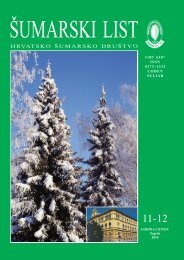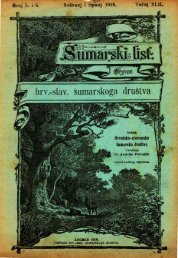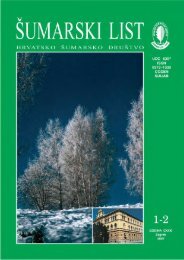You also want an ePaper? Increase the reach of your titles
YUMPU automatically turns print PDFs into web optimized ePapers that Google loves.
SI. 1. Ženka (lijevo) i mužjak gubara (Lymantria dispar<br />
L.) prilikom kopulacije na kori hrasta (u prirodi<br />
je inače redovito položaj para u kopulaciji<br />
vertikalan - ženka gore, mužjak dolje).<br />
Fig. 1 Female (left) and male of gypsy moth (Lymantria<br />
dispar L.) during copulation on oak bark (in natural<br />
conditions pair is oriented vertically - female<br />
above, male below).<br />
SI. 2. Ženka pored svježe odloženog jajnog legla.<br />
Fig. 2 Female with a freshly laid egg cluster.<br />
Jajne ličinke (prvi larvalni stadij) "na ogledalu"<br />
(u travnju, netom nakon eklozije mlade se gusjenice<br />
neko vrijeme zadržavaju na površini jajnog<br />
legla iz kojeg su eklodirale).<br />
Fig. 3 Egg larvae (first larval instar) on the egg cluster<br />
surface (in April, immediately after the eclosion,<br />
young larvae are confined to the place of their<br />
origin).<br />
SI. 4.<br />
Fig. 4<br />
Odrasla gusjenica gubara (snimljena polovicom<br />
lipnja).<br />
Fully grown gypsy moth larva (photo taken in<br />
mid June).<br />
(Tekst i fotografije B. Hrašovec)<br />
O gubaru (Lymantria dispar L.) je u domaćoj i stranoj literaturi napisano mnoštvo znanstvenih i stručnih priloga.<br />
Radi se o jednom od svjetski najpoznatijih šumskih defolijatora sa sposobnošću višestrukog i naglog povećanja<br />
gustoće populacije, što rezultira dramatičnim štetama na šumskom drveću. Zbog svoga biološkog svojstva<br />
već dugi niz godina u domaćoj šumarskoj praksi redovno se provodi nadzor gustoće njegovih populacija u svim<br />
šumama gdje se prirodno javlja. Odlučili smo ipak u okviru ovog redovnog priloga još jednom podsjetiti na neke<br />
detalje iz njegove biologije, s obzirom da nam prema nekim predznacima i dojavama sa terena predstoje godine<br />
povećanja njegove gustoće populacije, a moguće i potreba za provedbom neposrednih mjera suzbijanja.<br />
Large number of scientific and professional papers, both domestic as well as foreign, have addressed gypsy<br />
moth (Lymantria dispar L.) due to its leading position of being one of the world's best known forest defoliator.<br />
Because of the capability to enter into outbreak phase in a short time it has been monitored in Croatia on a yearly<br />
basis in forest ecosystems where it occurs naturally. In spite of being a well known organism and the fact of routinely<br />
conducted monitoring activities by a trained personell we decided to draw the attention of practitioners<br />
once again to some aspects of its biology. Our decision was spurred by the fact that some indications and information<br />
from the field suggest that we might expect some population buildup in the years to come.<br />
IZDAVAČ: HRVATSKO ŠUMARSKO DRUŠTVO uz financijsku pomoć Ministarstva<br />
znanosti i tehnologije Republike Hrvatske i Hrvatskih šuma d.o.o.<br />
Publisher: Croatian Forestry Society - Editeur: Societe forestiere croate -<br />
Herausgeber: Kroatischer Forstverein<br />
Grafička priprema: ŽUPANČIĆ H R d.o.o. - Zagreb<br />
Tisak: EDOK - Zagreb

















